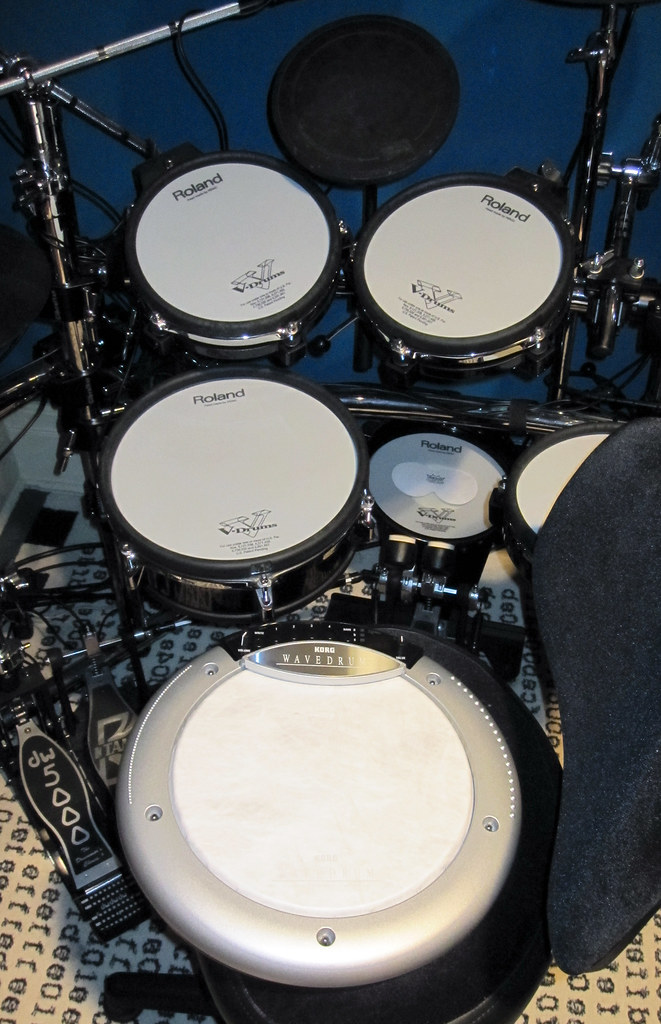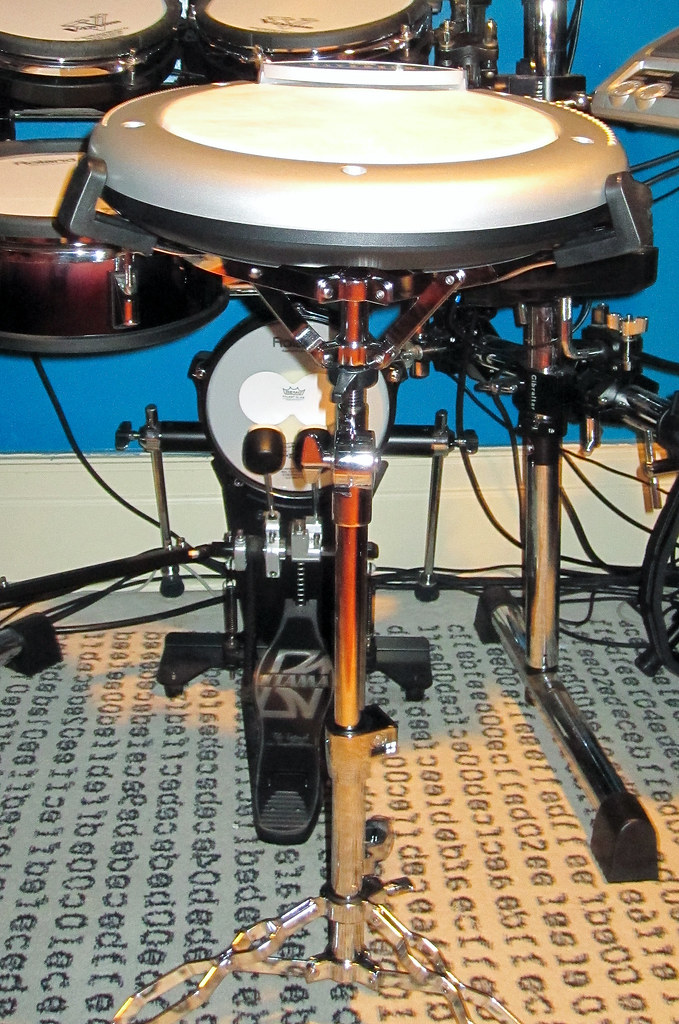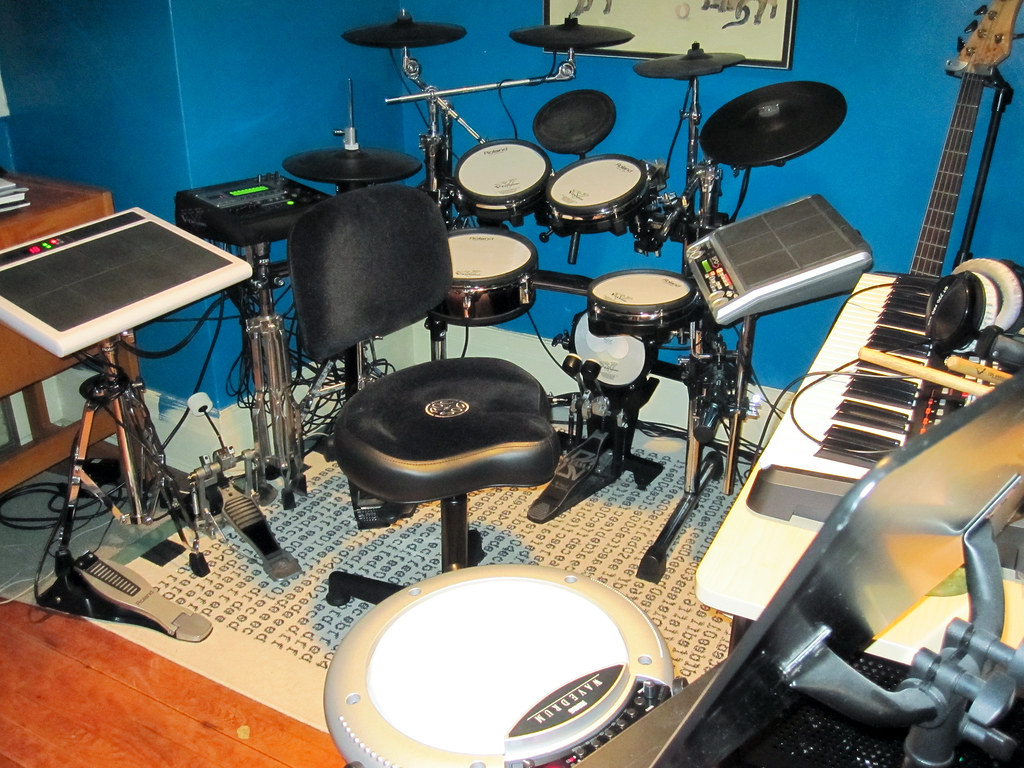Korg Wavedrum Review
Introduction and Features:
The original Wavedrum was a hand percussion instrument introduced by Korg in 1994 which allowed percussion players and drummers to incorporate a wide range of percussion and electronic instruments into their setup.
In 2009 Korg released the followup to the original Wavedrum, also called the Wavedrum. The new Wavedrum can be played with your hands, drum sticks, mallets, brushes or a combination of these. This updated version contains:
200 PCM samples assigned to either the rim or head.
DSP technology which is used to process the PCM samples.
100 factory presets, 100 user presets.
100 loop phrases which can be used for accompaniment.
An Aux In so you can connect an ipod or other audio device.
Construction and Physical Appearance:
When you unpack the Wavedrum the first thing you'll notice is its sturdy construction. The head itself is a heavy duty 10 inch drum head. While not as coarse as a coated snare drum head it will still produce a sound if you were to play with brushes. The rim is made out of thin sturdy aluminum, and has a notch section located on the upper left and right hand side. There are five tension bolts located around the drum which are used to adjust the tension. Located on the bottom of the drum is adjustment for pressure sensitivity. You use the included alen key to adjust pressure sensitivity.
The drum itself is about 4.5 pounds and measures 13.75 inches across. It can be mounted on either a snare drum stand or percussion stand. On the rear panel is the
Power connector
Power switch
L,R monaural 1/4" output jacks
Stereo miniplug headphone jack*
Stereo Aux In jack
At this point you may be wondering about the lack of MIDI ports, more on that later in the review.
*If you mount the Wavedrum on certain standard snare drum stands in a normal symmetrical fashion, The left snare drum mount will block access to the headphone input jack.*
The operating panel laid out across the top contains:
- Volume knob - controls the level sent to the headphones and to the L,R outputs.
- Write button - used for saving settings changes.
- Buttons 1-4 - used to change presets as well as editing programs.
- Bank/Mode - used to change preset banks as well as editing programs.
- Value knob - used to change presets as well as editing programs.
- Display - 3 character display used to show which program you are on in live mode or which parameter you are on in edit mode.
- Bank Display - 3 LEDs which depending on the mode you are in either display the bank you are using in live mode or which parameters you are editing in Edit mode.
Sounds:
Unlike most electronic based music instruments where previewing a sound is straight forward, the Korg Wavedrum is considerably more complex when it comes to previewing it's sounds. The reason behind this is that when you listen to one of the Korg presets, you are listening to several sounds that are being processed by one of the Wavedrum's algorithms.
You can think of an algorithm as a type of DSP processing which a PCM sample passes through before it is output from the Wavedrum. This DSP processing is a combination of analog, additive, non-linear, and physical modeling. There are 36 algorithms. 26 are "single-size" algorithms and are used when you want to assign a separate algorithm to the head and rim and there are 10 "double-size" algorithms which are highly specialized and used for simulating acoustic instruments. In the case where you are using a "double-size" algorithm, the algorithm is the sound, and a PCM sample cannot be specified separately.
There are 200 PCM samples which are broken up so that 100 can be used for the head and 100 can be used for the rim. Sounds are assigned to algorithms, meaning you assign head and rim PCM sounds to single-size algorithms.
Overall the sounds are very good, and even though you aren't able to add your own sounds the Wavedrum has a large variety to choose from. The sounds range from your typical percussion sounds such as Tablas, Congas, Bells, Djembe, Timbales, and Boca to orchestral percussion like Tympani and Orchestral cymbals. There are also a wide variety of "experimental" sounds such as, Vocoder, Bubble, and Metal Tree. Once you start experimenting with the sound combinations you'll soon discover the near limitless possibilities.
Performance:
Out of the box the Wavedrum performed very well for me. There are 100 factory presets setup and you can switch between them by turning the Value knob or by selecting one of the 12 predefined presets. One thing to keep in mind is that changing presets is very slow. It takes approximately 3 seconds for a new preset to load if you use the Value knob so I would recommend that you keep your most commonly used presets as part of the Live presets.
You can set the sensitivity of the drum Wavedrum using a combination of head/rim calibration, pressure calibration, velocity curves, head/rim sensitivity and by tuning the drum itself. I spent a lot of time tweaking these settings in order to get a comfortable feel for hands, mallets, sticks and brushes. Once calibrated to my playing style I was able to get a good dynamic range using my hands, stick, mallets, and plastic brushes.
The sensitivity on the Wavedrum is incredible. You can scratch your fingertip across the drum head and it will produce a sound. For those wondering why MIDI was not included, I can't imagine getting this kind of sensitivity and dynamics from any kind of electronic percussion instrument over MIDI.
Editing:
Once you've gone through the presets you are going to want to create your own. To do this you use a combination of front panel buttons to edit all the various parameters. These include:
- Tune: Allows you to change the pitch of the head or rim algorithm and the PCM sound.
- Decay: Specify the decay time for the head or rim algorithm and the PCM sound.
- Level: Specify the level of the head or rim algorithm and the PCM sound.
- Pan: Set the panning of the head or rim algorithm and PCM sound.
- Algorithm Select: Select a single-size or double-size algorithm and it's corresponding PCM sounds.
- Velocity Curve: Select a curve for how the volume or tone of a PCM sound will be affected by how hard you strike the head or rim.
- Pressure Curve: Select a curve for how the volume or tone will be affected by pressure applied to the head.
- Pressure Tune: Specifies how the pitch of the head or rim changes based on pressure applied to the head.
- Pressure Decay: Specify how the decay time of the head or rim PCM sound is affected by pressure applied to the head.
- Reverb: Set type of reverb along with various reverb parameters such as level and delay time.
- Delay: Set delay time along with amount of feedback and high-frequency dampening.
In addition to the above settings each algorithm has settings which are specific to the type of algorithm. For example, for a snare algorithm you can set things like shell type, and shell depth. There are also two global parameters that control global panning and the volume of the Aux In.
As you can see creating and editing new presets can get complicated quickly and you will want to keep the instruction manual handy. Because of the limited size of the display you will need to reference the included sound and algorithm sheet often. After experimenting with the various setting for an hour I was able to create several usable presets which I could use in a live or studio situation.
Loop Phrases:
There are 100 loops that come standard on the Wavedrum. These are percussion phrases in various styles. You have very little control over these phrases. In fact the only parameter you can control is the volume relative to the main percussion volume. While I found these phrases interesting, I don't know how useful they will be for most people.
Conclusion:
The Wavedrum is a very interesting product. It has excellent sounds, and provides a level of dynamics not seen in other electronic percussion products. That being said, it also does not provide a path for expandability. Since the Wavedrum lacks any kind of MIDI or USB connectivity, you cannot use it as a MIDI controller or trigger it's internal sounds from a controller. This also makes it impossible to backup your configuration, or for Korg to provide future firmware upgrades.
I don't think the Wavedrum will be a replacement for a full percussion setup, but I do think it would be great for any percussionist looking to expand into electronics. As with any piece of gear like this once you get over the "wow" factor you have to decide if it's right for you. There is a learning curve associated with the Wavedrum. While it's relatively simple to sit down play, you will want to spend time creating your own presets and working on various hand and stick techniques to get the most out of it.










